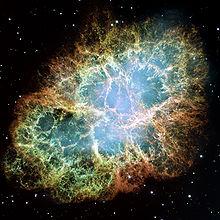

g  |
| Home | Creation Evidence | General Science Info | Old Earth Creation | Creation Time Line | Links |
| |
|
||
Do Neutrinos Matter? |
|||
|
By C. S. Davis
Aug 28, 2012
What is a neutrino? A neutrino is a very low mass, electrically neutral, sub-atomic particle released in numerous nuclear reactions. Neutrinos only weakly interact with other particles. So much so, that billions of neutrinos from the sun are passing through your body every second without effect. They can pass through planets, stars, and rarely interact with anything. Neutrinos and Supernovae. Neutrinos have long been known to play a roll in supernovae. When a star much more massive than the sun has exhausted the fuel within its core, the core begins to contract. The core will continue to contract since heat from fusion is not present to maintain the pressure required to overcome gravity. If the star is large enough, the core will collapse rapidly, only the neutrinos can escape, traveling through the stellar core. But as the rest of the stars material is falling into the core, the massive wave of neutrinos travel outward, carrying much of the energy with them. Though they normally interact only weakly, the shear numbers of them are enough to heat the contracting star to its bursting point, and the star explodes. The supernova explosion hurls the star's outer layers out into space, and in the process produces all naturally occurring elements beyond iron. All elements lighter than iron, beside Hydrogen and Helium, were made in stars. These manufactured elements would remain largely trapped within stars if it were not for supernova explosions that release them into space. In addition, elements heavier than iron are produced during the supernova itself. New research out of the University of California - San Diego has shown that the properties of the neutrinos have a rather significant effect on supernovae. The way they interact influences many aspects of the explosion, including the types of elements created in the blast. So do neutrinos make any difference to us? You might think that since these particles have so little effect on every day things that they do not matter to us. But without the heavier elements produced in stars and released through supernovae, there would be no rocky planets, moons, or asteroids anywhere in the universe. The observation that the constants of physics have just the right values to permit life and complexity in the universe is known as fine tuning. Some have disputed this evidence for God on the grounds that not all physical constants and properties have been found to be critical to the existence of life. But here we see that something as far removed from us as a neutrino, has properties that are acutely critical to our existence. Without the obscure properties of the neutrino, supernovae may not have been so efficient at spreading heavy elements around, making them available for planets and life. Without the laws of physics being fine tuned to an astounding degree of accuracy, life would be impossible. Even the properties of the neutrino are critical. Only an intelligent Creator could impart these values so precisely. For more on fine tuning, see our page on FINE TUNING. For other scientific evidence for God, see Evidence.
posted Aug 28, 2012 (c) 2012 RareUniverse.Org (see our terms of service) |